The Chemical Anchors Market is estimated to be valued at USD 1.4 billion in 2025 and is projected to reach USD 3.0 billion by 2035, registering a compound annual growth rate (CAGR) of 8.3% over the forecast period.
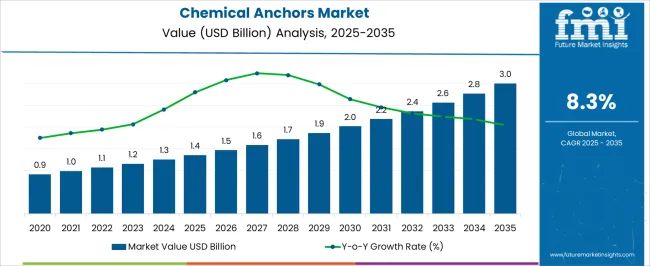
| Metric | Value |
|---|---|
| Chemical Anchors Market Estimated Value in (2025 E) | USD 1.4 billion |
| Chemical Anchors Market Forecast Value in (2035 F) | USD 3.0 billion |
| Forecast CAGR (2025 to 2035) | 8.3% |
The Chemical Anchors market is witnessing steady growth, driven by the increasing demand for reliable and durable fastening solutions across industrial and construction sectors. The current market scenario reflects heightened adoption of chemical anchoring systems due to their superior load-bearing capacity, resistance to environmental factors, and versatility in diverse structural materials. Growth is being further supported by rising investments in infrastructure projects, including bridges, tunnels, highways, and commercial buildings, which require high-performance anchoring solutions to ensure safety and long-term stability.
The development of advanced chemical formulations, improved installation techniques, and faster curing systems has strengthened market prospects. Additionally, regulatory emphasis on building safety standards and quality assurance is encouraging the use of chemical anchors over traditional mechanical fasteners.
The increasing focus on retrofitting, seismic strengthening, and urban redevelopment is expected to create substantial growth opportunities As the construction and infrastructure sectors continue to expand globally, chemical anchors are positioned as a critical component for structural reliability and performance, offering sustainable and scalable solutions for various industrial applications.
The chemical anchors market is segmented by product type, resin type, application, and geographic regions. By product type, chemical anchors market is divided into Injectable Chemical Anchors, Capsule Adhesive Chemical Anchors, and Chemical Anchor Fixings. In terms of resin type, chemical anchors market is classified into Pure epoxy Chemical Anchor, Unsaturated polyester Chemical Anchor, and Epoxy acrylate Chemical Anchor. Based on application, chemical anchors market is segmented into Infrastructure, Residential, Industrial, and Commercial. Regionally, the chemical anchors industry is classified into North America, Latin America, Western Europe, Eastern Europe, Balkan & Baltic Countries, Russia & Belarus, Central Asia, East Asia, South Asia & Pacific, and the Middle East & Africa.
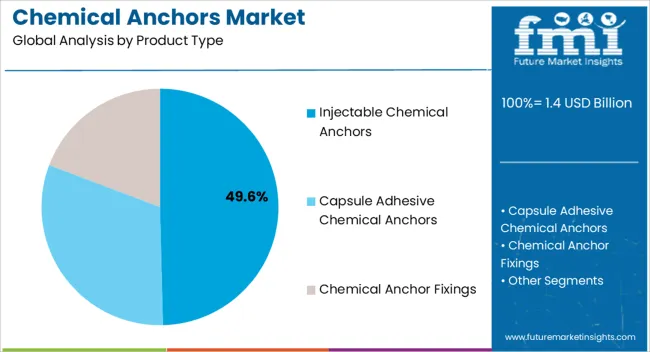
The injectable chemical anchors segment is projected to account for 49.60% of the overall Chemical Anchors market revenue in 2025, making it the leading product type. This dominance is being attributed to the versatility and high performance offered by injectable systems, which allow precise application in drilled holes of varying sizes and depths. These anchors are preferred in projects that require high load-bearing capacity and strong adhesion to concrete or masonry surfaces.
Growth in this segment has been supported by the increasing complexity of construction projects, where precision and reliability in fastening are critical. Injectable chemical anchors also allow for efficient installation in retrofitting and repair works without extensive structural modifications. Their adaptability to different environmental conditions, such as moisture and temperature variations, has further strengthened adoption.
The ability to achieve uniform bonding and long-term durability without mechanical expansion has positioned injectable chemical anchors as the preferred choice for contractors and engineers aiming for performance and structural integrity The segment is expected to maintain leadership due to its consistent reliability and suitability across diverse construction scenarios.
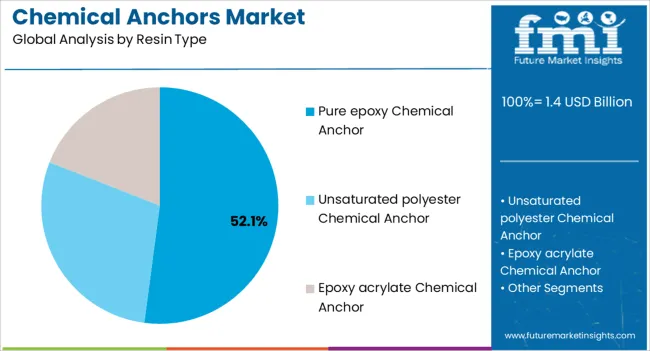
The pure epoxy chemical anchor segment is anticipated to hold 52.10% of the Resin Type market revenue in 2025, emerging as the dominant resin type. This position has been achieved because pure epoxy formulations provide superior mechanical strength, excellent adhesion, and resistance to chemical and thermal degradation. Growth in this segment has been influenced by increasing infrastructure and industrial applications where high-load bearing and long-term performance are critical.
The pure epoxy anchors ensure uniform stress distribution and structural stability, making them suitable for safety-critical applications such as bridges, tunnels, and high-rise buildings. The adaptability of pure epoxy chemical anchors to a wide range of environmental conditions, including wet or seismic zones, has further boosted adoption.
The segment’s expansion has also been facilitated by the growing preference for reliable and durable solutions in compliance with stringent construction standards As construction projects increasingly require materials that combine ease of installation with high structural performance, the pure epoxy segment is expected to sustain its leading share in the market through continuous innovation in chemical formulations and application techniques.
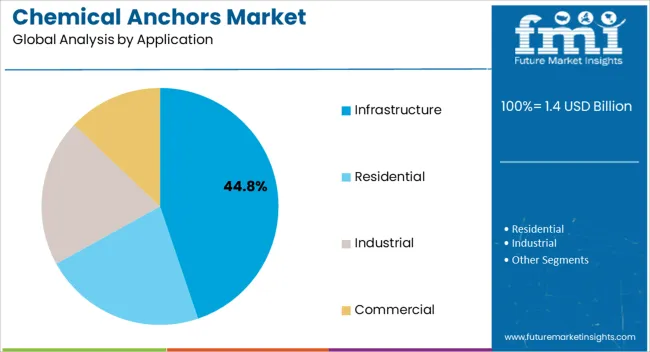
The infrastructure end-use segment is projected to hold 44.80% of the Chemical Anchors market revenue in 2025, making it the largest industry segment. This leadership is being driven by significant investments in bridges, tunnels, highways, and urban development projects, which demand high-performance anchoring systems for safety and structural integrity. Growth in this segment has been facilitated by the need for robust solutions capable of supporting heavy loads, resisting environmental stressors, and ensuring long-term stability.
Chemical anchors are increasingly preferred over mechanical fasteners for infrastructure projects due to their superior adhesion, load distribution, and adaptability to various materials. The segment has also benefited from the rising focus on retrofitting and seismic strengthening of existing structures, which require reliable chemical anchoring solutions.
Additionally, stringent building codes and safety regulations have reinforced the adoption of chemical anchors in critical infrastructure With the continued expansion of public works and transportation networks globally, the infrastructure segment is expected to remain the primary driver of chemical anchor demand, providing long-term growth potential for manufacturers and stakeholders in the market.
Chemical Anchoring is a process or technique for fastening the cement, concrete & the similar substrates that offer an increased level of flexibility & load bearing capacity. In numerous end use sectors mechanical & chemical anchoring is getting adopted in the very large scale but the later one i.e. chemical anchoring is gaining more adoption when compared to the mechanical anchoring. In chemical anchoring technique, a polymeric resin is introduced inside the hole prior to enclosure of the steel or iron stud.
With this process, the chemical resin naturally fills or seals in all voids & irregularities and consequently convert the hole airtight, with efficient adhesion. This additional adhesion with chemical anchoring creates superfluous strength. Mechanical anchoring is having its own limitations such as not ideal for imperfect shapes, prone to water ingress leading to corrosion, concentrated load at limited points, excessive torque destroys the fixing and many more. Chemical anchoring system able to address the above-said industry challenges. Moreover, chemical anchoring provides the opportunity to make minor adjustments to the screw’s orientation while curing which is not the case in mechanical anchoring process.
The non-expanding property of a chemically held rod in chemical anchoring is considerable decreases the chance of the adjacent concrete cracking. This property further helps for securing railings on to concrete stairs, or shallower slabs and related applications. In the commercial marketplace, there are numerous types of chemical anchors are available, out of which capsule adhesives chemical anchors, injectable chemical anchors, and chemical anchor fixings are the preferred ones.
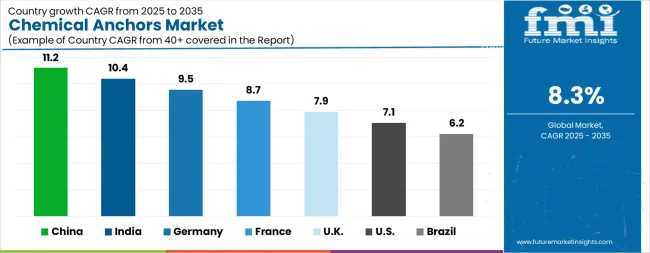
| Country | CAGR |
|---|---|
| China | 11.2% |
| India | 10.4% |
| Germany | 9.5% |
| France | 8.7% |
| UK | 7.9% |
| USA | 7.1% |
| Brazil | 6.2% |
The Chemical Anchors Market is expected to register a CAGR of 8.3% during the forecast period, exhibiting varied country level momentum. China leads with the highest CAGR of 11.2%, followed by India at 10.4%. Developed markets such as Germany, France, and the UK continue to expand steadily, while the USA is likely to grow at consistent rates. Brazil posts the lowest CAGR at 6.2%, yet still underscores a broadly positive trajectory for the global Chemical Anchors Market. In 2024, Germany held a dominant revenue in the Western Europe market and is expected to grow with a CAGR of 9.5%. The USA Chemical Anchors Market is estimated to be valued at USD 475.2 million in 2025 and is anticipated to reach a valuation of USD 939.5 million by 2035. Sales are projected to rise at a CAGR of 7.1% over the forecast period between 2025 and 2035. While Japan and South Korea markets are estimated to be valued at USD 71.3 million and USD 39.9 million respectively in 2025.
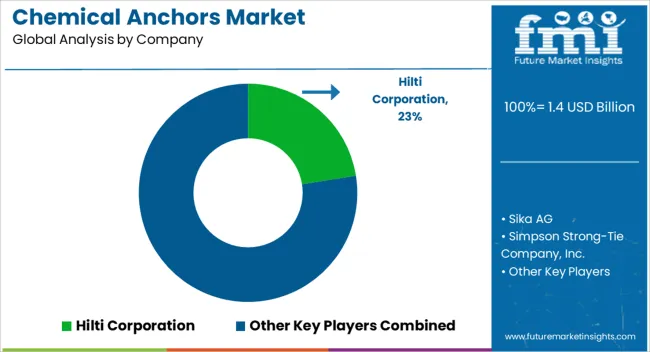
| Item | Value |
|---|---|
| Quantitative Units | USD 1.4 Billion |
| Product Type | Injectable Chemical Anchors, Capsule Adhesive Chemical Anchors, and Chemical Anchor Fixings |
| Resin Type | Pure epoxy Chemical Anchor, Unsaturated polyester Chemical Anchor, and Epoxy acrylate Chemical Anchor |
| Application | Infrastructure, Residential, Industrial, and Commercial |
| Regions Covered | North America, Europe, Asia-Pacific, Latin America, Middle East & Africa |
| Country Covered | United States, Canada, Germany, France, United Kingdom, China, Japan, India, Brazil, South Africa |
| Key Companies Profiled | Hilti Corporation, Sika AG, Simpson Strong-Tie Company, Inc., Illinois Tool Works Inc. (ITW), BASF SE, 3M Company, Henkel AG & Co. KGaA, Fischer Group, Powers Fasteners (Stanley Black & Decker), MKT Fastening LLC, DEWALT (Stanley Black & Decker), Mapei S.p.A., Rawlplug, and EJOT Holding GmbH & Co. KG |
The global chemical anchors market is estimated to be valued at USD 1.4 billion in 2025.
The market size for the chemical anchors market is projected to reach USD 3.0 billion by 2035.
The chemical anchors market is expected to grow at a 8.3% CAGR between 2025 and 2035.
The key product types in chemical anchors market are injectable chemical anchors, capsule adhesive chemical anchors and chemical anchor fixings.
In terms of resin type, pure epoxy chemical anchor segment to command 52.1% share in the chemical anchors market in 2025.






Our Research Products

The "Full Research Suite" delivers actionable market intel, deep dives on markets or technologies, so clients act faster, cut risk, and unlock growth.

The Leaderboard benchmarks and ranks top vendors, classifying them as Established Leaders, Leading Challengers, or Disruptors & Challengers.

Locates where complements amplify value and substitutes erode it, forecasting net impact by horizon

We deliver granular, decision-grade intel: market sizing, 5-year forecasts, pricing, adoption, usage, revenue, and operational KPIs—plus competitor tracking, regulation, and value chains—across 60 countries broadly.

Spot the shifts before they hit your P&L. We track inflection points, adoption curves, pricing moves, and ecosystem plays to show where demand is heading, why it is changing, and what to do next across high-growth markets and disruptive tech

Real-time reads of user behavior. We track shifting priorities, perceptions of today’s and next-gen services, and provider experience, then pace how fast tech moves from trial to adoption, blending buyer, consumer, and channel inputs with social signals (#WhySwitch, #UX).

Partner with our analyst team to build a custom report designed around your business priorities. From analysing market trends to assessing competitors or crafting bespoke datasets, we tailor insights to your needs.
Supplier Intelligence
Discovery & Profiling
Capacity & Footprint
Performance & Risk
Compliance & Governance
Commercial Readiness
Who Supplies Whom
Scorecards & Shortlists
Playbooks & Docs
Category Intelligence
Definition & Scope
Demand & Use Cases
Cost Drivers
Market Structure
Supply Chain Map
Trade & Policy
Operating Norms
Deliverables
Buyer Intelligence
Account Basics
Spend & Scope
Procurement Model
Vendor Requirements
Terms & Policies
Entry Strategy
Pain Points & Triggers
Outputs
Pricing Analysis
Benchmarks
Trends
Should-Cost
Indexation
Landed Cost
Commercial Terms
Deliverables
Brand Analysis
Positioning & Value Prop
Share & Presence
Customer Evidence
Go-to-Market
Digital & Reputation
Compliance & Trust
KPIs & Gaps
Outputs
Full Research Suite comprises of:
Market outlook & trends analysis
Interviews & case studies
Strategic recommendations
Vendor profiles & capabilities analysis
5-year forecasts
8 regions and 60+ country-level data splits
Market segment data splits
12 months of continuous data updates
DELIVERED AS:
PDF EXCEL ONLINE
Injection Epoxy Chemical Anchors Market Size and Share Forecast Outlook 2025 to 2035
Chemical Hydraulic Valves Market Size and Share Forecast Outlook 2025 to 2035
Chemical Vapor Deposition Market Forecast Outlook 2025 to 2035
Chemical Recycling Service Market Forecast Outlook 2025 to 2035
Chemical Dosing Equipment Market Size and Share Forecast Outlook 2025 to 2035
Chemical Filling System Market Size and Share Forecast Outlook 2025 to 2035
Chemical Absorbent Pads Market Size and Share Forecast Outlook 2025 to 2035
Chemical Indicator Inks Market Size and Share Forecast Outlook 2025 to 2035
Chemical Boiler Market Size and Share Forecast Outlook 2025 to 2035
Chemical Hardener Compounds Market Size and Share Forecast Outlook 2025 to 2035
Chemical Peel Market Size and Share Forecast Outlook 2025 to 2035
Chemical Protective Gloves Market Size and Share Forecast Outlook 2025 to 2035
Chemical Injection Pump Market Size and Share Forecast Outlook 2025 to 2035
Chemical Liquid Hydrogen Market Size and Share Forecast Outlook 2025 to 2035
Chemical Sensors Market Size and Share Forecast Outlook 2025 to 2035
Chemical Resistant EVA Film Market Size and Share Forecast Outlook 2025 to 2035
Chemical Resistant Fabrics Market Size and Share Forecast Outlook 2025 to 2035
Chemical Resistant Coating Market Size and Share Forecast Outlook 2025 to 2035
Chemical Distribution Market Size and Share Forecast Outlook 2025 to 2035
Chemical & Petrochemical IECS Market Size and Share Forecast Outlook 2025 to 2035

Thank you!
You will receive an email from our Business Development Manager. Please be sure to check your SPAM/JUNK folder too.
Chat With
MaRIA